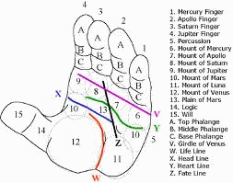If you ask a layman as to what he understands by ‘hand’, the simple answer would be that he does all his daily chores with his hands. In a way, he is right because that is what we all do. We eat, hold, open or close the doors and windows, put on our clothes, make gestures, and things like that. But if we study what numerous scholars have said and written about the ‘hand’, we come to know the various aspects of our life that our hands depict. Here we shall discuss the psychological personality traits of ‘hand’.
Describing the body language of the hands, Joe Navarro (2010) posted, “You may not have noticed but when you feel strong and confident, the space between your fingers grows to make your hands more territorial. When you feel insecure, that space disappears you may find yourself tucking your thumbs under your fingers when under a lot of stress.” (Navarro). This was a psychological interpretation by Navarro.
Let us now study the significance of the lines on our palms. Women have more lines on their hands than men. These lines grow and increase in number as we grow. Normally our hands have four major lines and several minor lines. The major lines are the Heart Line, the Head Line, the LifeLine, and the Fate Line. If these lines are construed properly, we can know a lot of psychological information about ourselves, and this information can be used to uncurl the problems of our lives.
In this regard, Andrew Fitzherbert (1989) expressed his views as follows, “Hand psychology is a new, effective tool for solving your problems. The answers to many nagging difficulties which crop up day to day are, quite literally, right there in your hands. Half the problems which send people racing to psychologists, counselors and other high-priced experts can be solved by a study of the human hand.” (Fitzherbert, ii). The figure below shows a typical hand and the various lines that are used to evaluate the personality and other aspects of any human being.

There are three major ways (somewhat complex) in which our hands reveal our character. Firstly, most of our characteristics are hereditary. These are depicted by way of lines on our hands. Secondly, some of the characteristics are controlled by our body, especially hormones. They have almost complete control over our bodies and our actions. Thirdly, there is a close link between our hands and our brain. Normally, people think that the lines on our hands are formed by the way we fold our hands. But the fact is that the lines are formed as the nervous system wants them to be.
Not only the lines but even the shape and size of our hands reveal a lot. Anu Venkat (2002) wrote, “Types of hands, their shapes, finger lengths, and mounts count far less insignificance when viewed against the highly complex and myriad manifestations of different patterns of lines on our palm, each such line alignment portending different degrees of specific life event, disease or temperament.” (Venkat, 6). The hormone chemicals have a significant effect on our behavior and also on the size and shape of our hands.
There are a few other aspects of the functions of our hands. By way of our body language, hands help express our views strongly. We can express our feelings for someone by holding his or her hands. Dumb people converse using their hands. Hence we observe that hands are not as simple as they look. They have the complete representation of a human being in them.
Works Cited
Fitzherbert, A. Hand Psychology: A New Insight Into Solving Your Problems. United Kingdom: Penguin, 1989. Print.
Navarro, J. Psychology Today. Spycatcher. 2010.
Venkat, A. Palmistry, A True Science. Victoria, Canada: Trafford Publishing, 2002. Print.